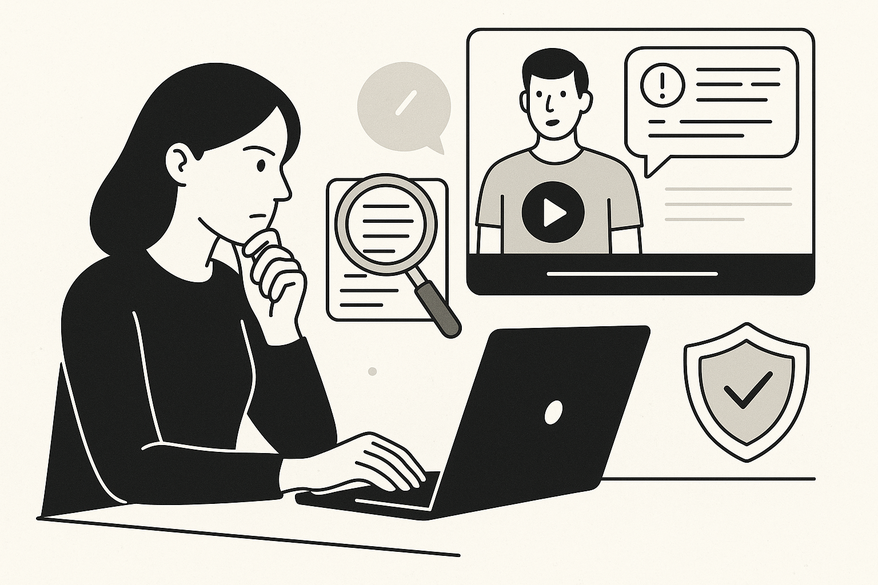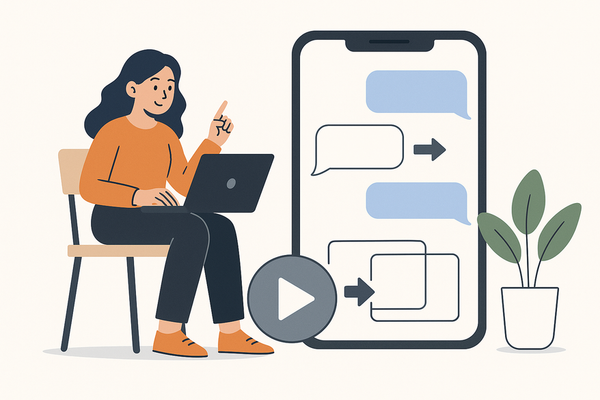Common Fake Chat Video Questions: Your Guide to Spotting Scripted Prompts
Learn to identify scripted fake chat video questions and understand their impact on trust. Enhance your digital content analysis skills with our comprehensive guide.

Estimated reading time: 8 minutes
Key Takeaways
- Scripted prompts mimic real messaging apps to drive engagement.
- The top eight questions leverage drama, curiosity, and emotional hooks.
- Psychological triggers like curiosity gaps, FOMO, and empathy boost virality.
- A clear checklist helps spot fake chat videos: timestamps, UI inconsistencies, phrasing.
Table of Contents
- Introduction
- Defining Fake Chat Videos
- Origins and Popularity
- Exploring Common Fake Chat Video Questions
- The Psychology Behind These Questions
- How to Identify and Evaluate Fake Chat Video Questions
- Impact on Online Communication
- Conclusion
- FAQ
Introduction
Introduction
Fake chat videos are scripted prompts embedded within simulated chat-style videos that aim to grab attention and drive engagement. In recent years, fake chat videos have exploded across social media, mimicking real messaging interfaces to blur the line between authentic conversations and staged drama. Viewers often search for common fake chat video questions to learn how to spot these contrived setups and avoid falling for sensational content.
This post will define what makes a chat video fake, trace its rise in today’s online media landscape, and explore the eight most common fake chat video questions. You’ll discover the psychology behind these prompts, a clear checklist to identify them, and the broader impact on trust and digital discourse. By the end, you’ll be equipped to analyze and evaluate fake chat videos—becoming a more savvy consumer of digital content.
For creators aiming to craft convincing chat narratives, tools like Vidulk - Fake Text Message Story App offer intuitive interfaces and AI-powered generation. Here’s a quick overview video showcasing how simple it is to generate chat-based stories:
Section 1: Defining Fake Chat Videos
What are fake chat videos?
Fake chat videos simulate real messaging apps by presenting pre-scripted conversations as if they happened live. They borrow familiar interfaces—WhatsApp, Messenger, Tinder—to create the illusion of authenticity using:
- Customized names, avatars, timestamps
- Staged dialogue instead of organic replies
- Perfectly aligned message bubbles across platforms
- Illogical time gaps that ignore real typing delays
Core elements that distinguish them from authentic conversations:
- Scripted prompts rather than spontaneous replies
- Perfectly aligned timestamps or illogical time gaps
- Uniform message bubble styles across different apps
A real-world example: A popular TikTok clip shows two friends “arguing” about a secret crush. The timestamps jump from 1:02 PM to 3:47 PM in one second—an impossible leap in real chats. Yet the video amassed millions of views because it looks real at first glance.
Citations:
fake chat video dating guide
how to create a fake chat
Section 2: Origins and Popularity
Trend roots in meme culture and short-form platforms
Early prank videos on Vine and Tumblr sparked interest in quick, chat-style gags. TikTok and Instagram Reels unlocked mass reach for 15–60 second stories, boosting fake chat formats.
Accessible tools fuel growth
Chat-generator tools and video editors let anyone mock up realistic interfaces without coding. (Source: fake chat video dating guide) The rise of short-form platforms encouraged bite-sized storytelling via chat mockups. (Source: how to create a fake chat)
Creator motivations
- Humor: Parody everyday misunderstandings.
- Drama: Stage shocking reveals or relationship twists.
- Pranks: Fool friends with believable “leaks.”
- Scams: Lure clicks to shady offers or phishing sites.
By turning everyday messaging into a visual narrative, creators tap into shared digital experiences—and viewers can’t help but pause and read their screens.
Section 3: Exploring Common Fake Chat Video Questions
These scripted prompts are designed to hook viewers and drive engagement. Below are the top eight questions with scenarios and intended reactions:
- “Are you serious right now?” (Drama Hook)
Example: A friend reveals they dropped out of college without warning.
Reaction: Shock, disbelief, and shares. - “Did you really just say that?” (Shock Factor)
Example: A partner admits an outrageous rumor.
Reaction: Gasping, replaying the clip, tagging friends. - “Who is this?” (Mystery Hook)
Example: An anonymous number texts a dramatic confession.
Reaction: Speculation, comments guessing the sender. - “Do you still love me?” (Emotional Hook)
Example: An ex-partner attempts reconciliation.
Reaction: Empathy, nostalgia, and emotional engagement. - “Can I tell you a secret?” (Curiosity Gap)
Example: “I’ve been hiding something huge….”
Reaction: Eager clicks, comments begging for details. - “Will you forgive me?” (Conflict Hook)
Example: A mistake threatens a friendship or relationship.
Reaction: Sympathy, debate in comments. - “What would you do if I told you X?” (Speculation)
Example: “What if I told you I’m moving abroad?”
Reaction: Creative replies, polls, viewer interaction. - “Send a pic?” (Visual Engagement)
Example: “Show me your new tattoo.”
Reaction: UGC—viewers post their own images in comments.
Section 4: The Psychology Behind These Questions
Key psychological drivers
• Curiosity gap: Unanswered questions compel clicks and shares.
• Social proof and FOMO: Seeing others react to drama triggers fear of missing out.
• Emotional engagement: Empathy, indignation, humor spark discussions and virality.
How open-ended questions fuel engagement
Research shows that ambiguous prompts like “Can I tell you a secret?” boost comment rates by 30%, as users feel compelled to react or ask follow-up questions. AI-generated scripts exploit this by consistently delivering cliffhangers and sensational hooks.
Section 5: How to Identify and Evaluate Fake Chat Video Questions
Use this step-by-step checklist to spot fake chat videos and their scripted prompts:
- Examine timestamps for inconsistencies
Look for too-perfect or erratic time jumps that defy typing speed. - Look for generic or over-the-top phrasing
Real chats include typos, emojis, and hesitations; scripted lines are polished or sensational. - Inspect UI details
Check for mismatched icons, odd battery indicators, or notification banners borrowed from other platforms. See also chat video editing tips. - Cross-reference names and photos
Reverse-search profile pics and usernames to confirm authenticity. - Search for the same script on other platforms
Use reverse-image or phrase search to find identical text or screenshots.
Red flags to watch for:
• Repeated ambiguous question templates across multiple videos (learn common pitfalls: fake chat video mistakes)
• Abrupt context shifts with no backstory or setup
• Pop-culture or sensational references pasted into a “chat”
Section 6: Impact on Online Communication
Eroding trust and authenticity
Fake chat videos blur reality, causing viewers to doubt genuine conversations and news stories. Misinformation campaigns can weaponize scripted prompts to spread rumors and scams. (Creators should follow ethical guidelines outlined in ethical considerations for fake chat videos.)
Responsibilities for creators and viewers
Creators should:
- Label staged content when possible
- Avoid malicious deception that could harm individuals
Viewers should:
- Verify stories before sharing
- Question sensational narratives and look for original sources
Conclusion
Common fake chat video questions are carefully engineered prompts within staged chat videos designed to provoke emotional reactions and boost engagement. Understanding how these questions work—and why creators use them—is key to preserving trust in digital communication. Use the checklist above and apply critical thinking when confronted with “Are you serious right now?” or “Can I tell you a secret?” to separate scripted drama from genuine conversation.
Call to Action
Have you encountered other fake chat questions that made you pause? Share your examples in the comments below. For more tips on spotting fake chat videos and online misinformation, subscribe to our newsletter and stay informed.
FAQ
How can I tell if a chat video is fake?
Check timestamps for impossible jumps, look for pristine phrasing without typos, and inspect UI elements for mismatched icons or unnatural layouts.
What prompts are most commonly used in fake chat videos?
The top scripted hooks include “Are you serious right now?”, “Can I tell you a secret?”, and “Who is this?”, all designed to spark curiosity and drama.
Are there tools to create realistic chat videos for legitimate purposes?
Yes. Apps like Vidulk - Fake Text Message Story App provide AI-powered interfaces for crafting chat-based narratives responsibly.





